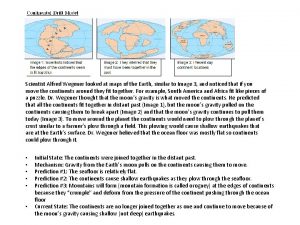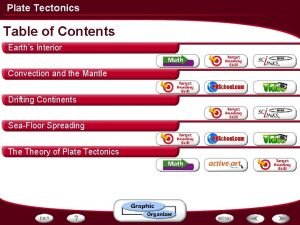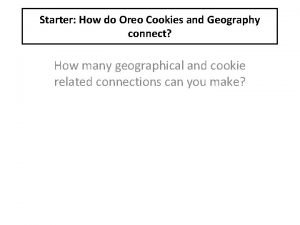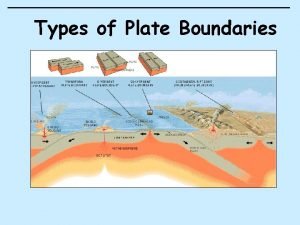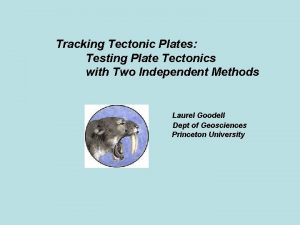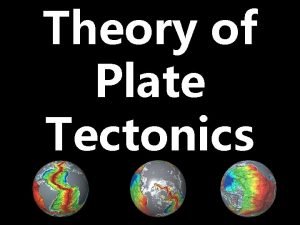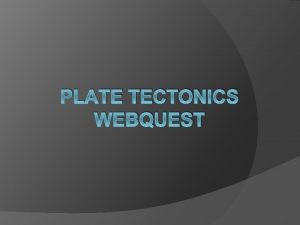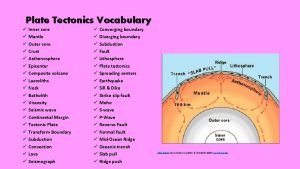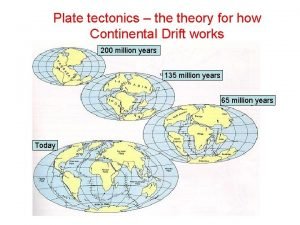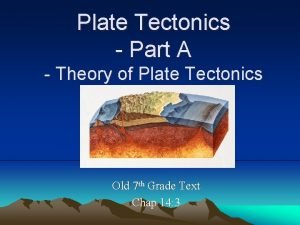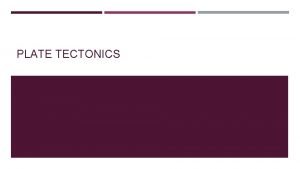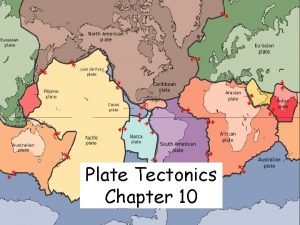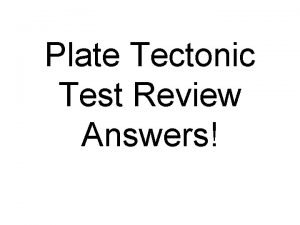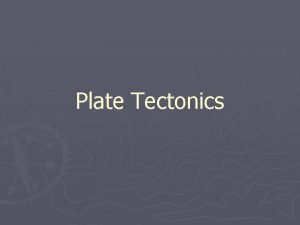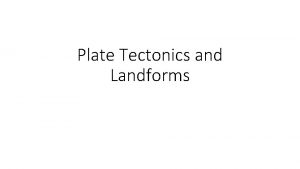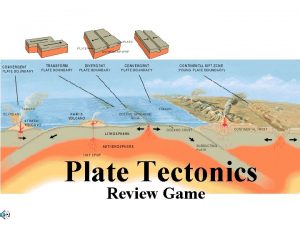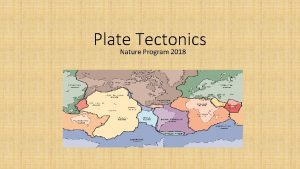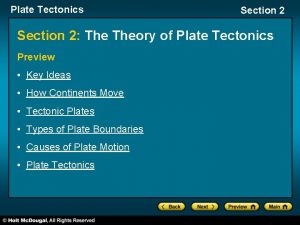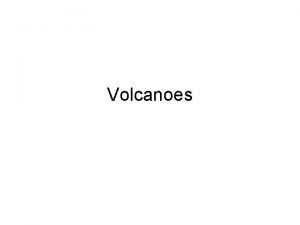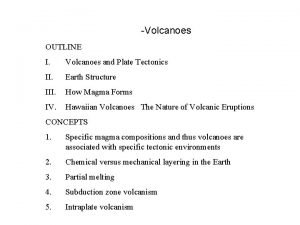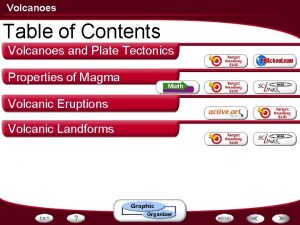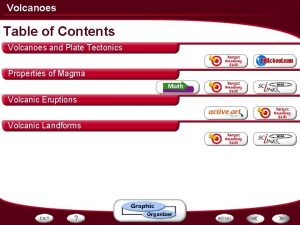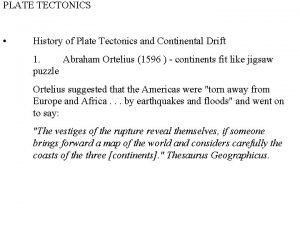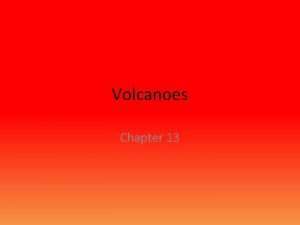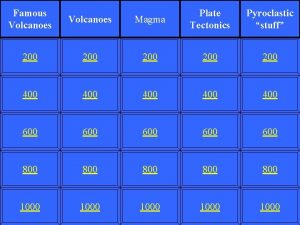Volcanoes Section 1 Volcanoes and Plate Tectonics Preview


















- Slides: 18

Volcanoes Section 1: Volcanoes and Plate Tectonics Preview • Key Ideas • Volcanoes and Plate Tectonics • Formation of Magma • Volcanism • Major Volcanic Zones • Intrusive Activity • Magma Formation

Volcanoes Section 1 Key Ideas • Describe three conditions under which magma can form. • Explain what volcanism is. • Identify three tectonic settings where volcanoes form. • Describe how magma can form plutons.

Volcanoes Section 1 Volcanoes and Plate Tectonics • Some volcanic eruptions can be more powerful than the explosion of an atomic bomb. • The cause of many of these eruptions is the movement of tectonic plates. • The movement of tectonic plates is driven by Earth’s internal heat.

Volcanoes Section 1 Formation of Magma • Most of the mantle remains solid because of the large amount of pressure from the surrounding rock. • magma liquid rock produced under Earth’s surface • Magma can form under three conditions: 1. If the temperature of the rock rises above the melting point of the minerals the rock is composed of, the rock will melt. 2. If enough pressure is removed from the rock, the melting point will decrease and the rock will melt. 3. The addition of fluids, such as water, may decrease the melting point of some minerals in the rock and cause the rock to melt.

Volcanoes Section 1 Volcanism • volcanism any activity that includes the movement of magma toward or onto Earth’s surface • Magma rises upward through the crust because the magma is less dense that the surrounding rock. • As bodies of magma rise toward the surface, they become larger in two ways: 1. Because they are so hot, they can melt some of the surrounding rock. 2. As the magma rises, it is forced into cracks in the surrounding rock.

Volcanoes Section 1 Volcanism, continued • lava magma that flows onto Earth’s surface; the rock that forms when lava cools and solidifies • As lava flows from an opening, or vent, the material may build up as a cone or material that eventually forms a mountain. • volcano a vent or fissure in Earth’s surface through which magma and gases are expelled

Volcanoes Section 1 Major Volcanic Zones • Like earthquakes, most active volcanoes occur in zones near both convergent and divergent boundaries of tectonic plates. • A major zone of active volcanoes encircles the Pacific Ocean. • This zone, called the Pacific Ring of Fire, is formed by the subduction plates along the Pacific coasts of North America, South America, Asia, and the islands of the western Pacific.

Volcanoes Section 1 Major Volcanic Zones, continued Subduction Zones • Many volcanoes are located along subduction zones, where one tectonic plate moves under another. • When a plate that consists of oceanic lithosphere meets one that consists of continental lithosphere, the denser oceanic lithosphere moves beneath the continental lithosphere. • A deep trench forms on the ocean floor along the edge of the continent where the plate is subducted. • The plates that consists of continental lithosphere buckles and folds to form a line of mountains along the edge of the continent.

Volcanoes Section 1 Major Volcanic Zones, continued Subduction Zones, continued • As the oceanic plate sinks into the asthenosphere, fluids such as water from the subducting plate combine with crust and mantle material. • These fluids decrease the melting point of the rock and cause the rock to melt and form magma. Some of the magma breaks through the overriding plate to Earth’s surface. • Over time, a string of volcanic mountains, called an island arc, forms on the overriding plate. • As more magma reaches the surface, the islands become larger and join to form one landmass, such as the volcanic islands that joined to form present-day Japan.

Volcanoes Section 1 Reading Check When a plate that consists of oceanic crust and one that consists of continental crust meet, which plate subducts beneath the other plate? The denser plate of oceanic lithosphere subducts beneath the less dense plate of continental lithosphere.

Volcanoes Section 1 Major Volcanic Zones, continued Mid-Ocean Ridges • The largest amount of magma comes to the surface where plates are moving apart at mid-ocean ridges. • As plates pull apart, magma flows upward along the rift zone. This magma erupts to form underwater volcanoes. • Most volcanic eruptions that happen along mid-ocean ridges are unnoticed by humans because the eruptions take place deep in the ocean.

Volcanoes Section 1 Major Volcanic Zones, continued Hot Spots • hot spot a volcanically active area of Earth’s surface, commonly far from a tectonic plate boundary • Most hot spots form where columns of solid, hot material from the deep mantle, called mantle plumes, rise and reach the lithosphere. • As magma rises to the surface, it breaks through the overlying crust. Volcanoes can then form in the interior of a tectonic plate.

Volcanoes Section 1 Major Volcanic Zones, continued Hot Spots, continued • The lithospheric plate above a mantle plume continues to drift slowly. • So, the volcano on the surface is eventually carried away from the mantle plume. • The activity of the volcano stops because it has moved away from the hot spot that supplied it with magma. • However, a new volcano forms where the lithosphere has moved over the mantle plume.

Volcanoes Section 1 Major Volcanic Zones, continued The diagram below shows hot spots and mantle plumes.

Volcanoes Section 1 Reading Check Explain how one mantle plume can form several volcanic islands. As the lithosphere moves over the mantle plume, older volcanoes move away from the mantle plume. A new hot spot forms in the lithosphere above the mantle plume as a new volcano begins to form.

Volcanoes Section 1 Intrusive Activity • As magma moves upward, it pushes into, or intrudes, the overlying rock. • Because of magma’s high temperature, magma affects surrounding rock in a variety of ways. • Rock that falls into the magma may eventually melt, or the rock may combine with the new igneous rock, which is rock that forms when the magma cools.

Volcanoes Section 1 Intrusive Activity, continued • When magma does not reach Earth’s surface, the magma may cool and solidify inside the crust. • This process results in large formations of igneous rock called plutons. • Small plutons called dikes are tabular in shape and may be only a few centimeters wide. • Batholiths are large plutons that cover an area of at least 100 km 2 when they are exposed to Earth’s surface.

Volcanoes Magma Formation Click below to watch the Visual Concept. Section 1
 Continental drift theory and plate tectonics theory
Continental drift theory and plate tectonics theory Compare continental drift and plate tectonics
Compare continental drift and plate tectonics Seafloor spreading material at trenches
Seafloor spreading material at trenches Continental drift vs plate tectonics theory
Continental drift vs plate tectonics theory Edible tectonic plates
Edible tectonic plates Oreo cookies and plate tectonics answer key
Oreo cookies and plate tectonics answer key Plate tectonics vs continental drift
Plate tectonics vs continental drift What are the four types of boundaries
What are the four types of boundaries Evidence of the theory of plate tectonics
Evidence of the theory of plate tectonics Plate tectonics theory states that
Plate tectonics theory states that Webquest plate tectonics
Webquest plate tectonics Plate tectonics vocabulary worksheet
Plate tectonics vocabulary worksheet Continental drift
Continental drift Plate tectonics definition
Plate tectonics definition Driving force of plate tectonics
Driving force of plate tectonics What is this process called
What is this process called Summarize the theory of plate tectonics
Summarize the theory of plate tectonics Harry hess and seafloor spreading
Harry hess and seafloor spreading Plate tectonics test review answer key
Plate tectonics test review answer key

